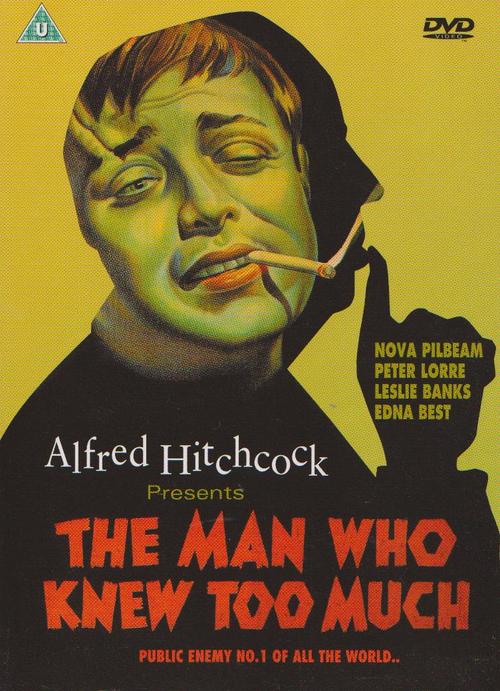The Man Who Knew Too Much (Enhanced Edition) 1934
THE STORY:
Picture the scene. Not so long after an Olympic competition has finally ended, hidden nearby, a shrouded saboteur shoots one of its contestants dead. BANG! However, before said contestant can kick the bucket, he quickly whispers
the location of a secret document to one of his fellow competitors, who then tells her
husband, thus forcing him to retrieve it as soon as possible.
Now I hope you've taken all of that in, folks. Because what
I want you to factor in next, is to imagine that the competitor is a great lady
called Jill Lawrence (Edna Best), her husband is a nice chap called Bob Lawrence
(Leslie Banks), and their daughter, Betty (Nova Pilbeam), gets kidnapped because
of what the Lawrence 's have in
their possession.
Oh, yeah! Straight up! This is one of those adventures. One
where Bill and his pal, Clive (Hugh Wakefield), travel from Switzerland to
London, and then from a stately home to a dentists chair, figuring out along
the way that the mastermind behind this dastardly scheme is none other than two
foreign spies known as Abbott and Ramon (Peter Lorre and Frank Vosper), who both
want to kill a dignitary visiting Old London Town.
Still. That's most probably why what next transpires all
goes to pot when Bill and Clive walk into a church. As a religion looks mean -
the Albert Hall is a scream - a siege turns into a shootout - and at the end
of the day family is what it's really all about.
THE REVIEW:
Now if I had to
sum up 'The Man Who Knew too Much' in one pithy phrase, I'd say that this great
film has 'The three C's, baby'. Yeah. 'The three C's'.
And, pray tell, what are these 'three C's' I'm referring to? Well, the first 'C' I'm talking about would have to be the word 'Crude' -- because compared to some
of today's much more slicker productions, the framing and the contents of
certain scenes could easily be defined as 'crude'.
As for the second 'C' on the other hand, I'd use the word 'Character'
-- because this movie has it in spades. From how certain characters behave, to
how certain characters speak. Bar none, this flick is chock full of 'character'.
The last 'C', though, is a word I didn't think I would assign
to a slice of cinema made in 1934. And that is because this 'C' is the word 'Captivating'.
Yeah. I'm not messing about, dear reader. All the way through this film I
couldn't help but become captivated by the story it was trying to tell. Part's
of it were your fairly linear murder mystery. Whilst other parts of it were your espionage
type 'film noir'. With all of the different shades of black and white clearly
defined in a tapestry made from shades of grey.
But wait up. Before I get too poetic about this piece, pal. Here.
Check out these filmic-facts. (1) 'Gaumont British' first released this forty
thousand pound production on the same month that Wiley Post first discovered
jet stream -- December, 1934. (2) Apart from those scenes shot at Lime Grove
Studios, Shepherd's Bush, the rest of this movie was shot on location at Tower
Bridge South Kensington ,
and the Royal Albert Hall. (3) The only thing this film has in common with the
book written by G. K. Chesterton is its name. Alfred
Hitchcock, who directed this flick, decided to pinch this title from this 1922 anthology, because he owned
the rights to some of the stories within it. (4) This picture was Peter
Lorre's first English language film. Most of his previous film work was
spoken in his native Hungarian tongue. (5) Despite receiving rave reviews, the producer
on this movie, C.M. Woolf, hated it so much, that he only released it as
the bottom half of a double bill. (6) The gun battle at the end of this
thriller was based on the Sidney Street
siege, which was a real gun fight that took place in Stepney, East
London , on the 3rd of
January, 1911 . (7) Alfred Hitchcock remade the film for 'Paramount
Pictures' twenty-two years later with James Stewart and Doris Day. It was the
only film he ever remade. (8) Not only has this adventure been referenced in two movies -- 'Oliver Twist, and 'The Evil Eye' -- but it has also been spoofed in an
episode of 'The
Simpsons' and the 'Muppet Babies' respectively.
Hey! Do you know what? I just thought of something else I
could compare 'The Man Who Knew too Much' to.
No. Not me, silly. A comic book.
Oi! Don't groan. You must know by now that's how my brain
works. Amalgamating comics and movies into one fun packed-package. Yet honest to Hitchcock, folk, how
this film appears to be shot and structured does make me think of it as
something like the Vertigo title, 'Sandman Mystery Theatre'.
Well, if you've picked up this series in the past, you might
have a pretty good idea what I mean by this comparison. If you haven't, though, try to imagine
a selection of panels on a comic book page, with the tones disaturated, the
story enveloping, and the overall sentiment timely and warm.
Oh, yeah! I suppose that's another way of summing up 'The
Man Who Knew too Much'! Warm. Very warm. Just like my
pithy expression I used at the start of this review -- 'The three C's, baby'.
Yeah. The three C's
THE RATING: A-
THE MAN WHO KNEW TOO MUCH (1934)
 Reviewed by David Andrews
on
August 27, 2013
Rating:
Reviewed by David Andrews
on
August 27, 2013
Rating:
 Reviewed by David Andrews
on
August 27, 2013
Rating:
Reviewed by David Andrews
on
August 27, 2013
Rating:








